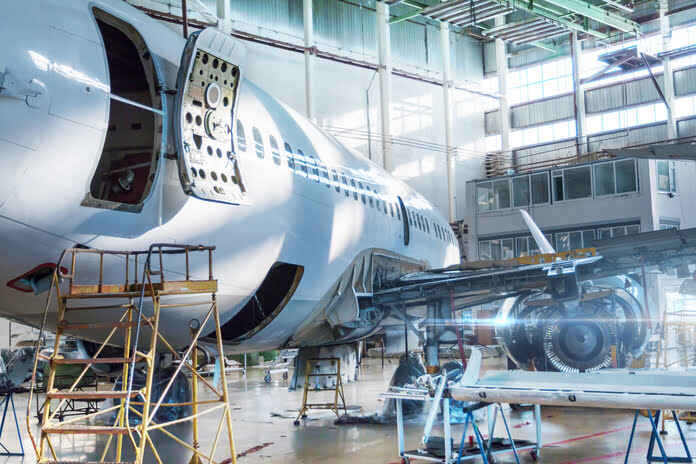An ideal investment in the aircraft business, in my opinion, is more than just an investment in original equipment manufacturers. There are also appealing prospects in the services and supply chain that support the aircraft industry. Park Aerospace (NYSE:PKE) and AerSale (NASDAQ:ASLE) are two instances. In this post, I will cover CPI Aerostructures (NYSE:CVU), which recently published fourth-quarter earnings, and analyze the stock price possibilities.
CPI Aerostructures Information
CPI Aerostructures has a market capitalization of less than $50 million, making it a relatively unknown name. As a result, a brief overview may be beneficial. CPI Aerostructures manufactures structural assemblies for Tier 1 and Tier 2 suppliers, as well as for the Department of Defence as a prime contractor. The company’s primary concentration is defense, with very little exposure to commercial aircraft.
Aerostructures CPI
CPI Aerostructures is involved in numerous programs. Unfortunately, the last time we were given a timeline for each or many of the programs was two years ago, but we do know that some programs, such as Lockheed Martin’s F-16, F-35, CH-35K, and UH-60 Black Hawk, have significant revenue generation potential ahead. With the strong momentum in defense, one can conclude that CPI Aerostructures has a bright future. However, the fact is that the first significant contract flows are projected in 2024, with deliveries following in later years. For a company like CPI Aerostructures, this will primarily result in the extension of multi-year programs rather than major rate breaks that give increased revenues from one day to the next. Aside from that, certain running programs compensate for legacy program completion.
With that in mind, it is always encouraging to see contracts like the one just announced for welded assembly worth $3.6 million. Despite their small size, these contracts bring value and consistency to CPI Aerostructures.
Boeing
According to what I’ve read about CPI Aerostructures on this site, management had to write off several programs, resulting in huge losses, and the accounting was characterized as error-prone. CPI Aerostructures had to restate its financial records, however, describing the losses as enormous and the accounting approach that led to prior losses as error-prone is inaccurate. The cost-completion technique, in which a portion of revenue is recognized as expenditures are spent, is used in the defense industry because programmes can last years if not decades. Occasionally, catch-up changes will be performed. Concerning the 2014 A-10 Thunderbolt charge, it was precipitated by an earlier end of the wing replacement program, and this was not due to management error. The reason for this was that the Air Force was under budget constraints, requiring it to retire the A-10 Thunderbolt and no longer invest in it, while prioritizing the F-35 as its replacement. As a result, fewer wing replacements were conducted than planned, resulting in lower revenues and higher unit costs, suggesting worse margins, therefore the revenue recognized on the program to date is excessive and must be returned. On ongoing programs with all defense companies, this is known as catch up adjustments, which can be both negative and positive. In the case of program termination, those adjustments are obviously negative, although early program termination is rarely usual. It does occur in the defense business, but it is not something that happens every day, or even every year.
Furthermore, when the costs of the F-35 for production and operations are considered, the option of the F-35 versus rewinding the A-10s makes little sense, which was recognized by Congress, and the decision to retire the A-10s was reversed. According to data from the evoX Defence Monitor, by 2019, the US Air Force awarded Boeing, the prime contractor on the A-10 wing replacement program, an indefinite-delivery, indefinite-quantity contract worth $999 million for up to 112 new A-10 wing assemblies and up to 15 wing kits. Boeing then awarded a $48 million IDIQ contract to CPI, offsetting the $47 million charge when the contract vehicle was fully utilized. That clearly demonstrates that neither management nor the accounting practice was at fault. Claiming one of the two is simply a misunderstanding of what occurred.
Aerostructures CPI
Revenues fell by about 20% year on year, while net income climbed by 35%. This was caused, however, by a revaluation of the company’s deferred tax assets. When we look at income from operations, we observe a 53% increase or a margin expansion of over 3% points and even 5.1 percent points on the gross margin level due to good mix impact and operational improvements. Income before taxes fell from $6.8 million to $2.6 million, however, this was due to a $4.8 million loan from the CARES Act.
CPI Aerostructures Forecast for 2023
The company predicts marginally greater revenues in 2023, which falls short of the $116 million analyst expectation, which would suggest a 40% increase in revenues. A recurring feature of analyst forecasts is that they do not always accurately reflect what the firm is aiming toward, which I believe is problematic given that many investors use these projections as a starting point when conducting due diligence.
CPI Aerostructures: It’s Difficult to See Any Gains In Stock Value Aerostructures CPI
I believe that a meaningful upside for the stock is unlikely. I calculated an enterprise value of $70.3 million and an EBITDA of $6.8 million utilizing an EBITDA margin expansion to 8% and revenue growth of 2.5%. Using a 6.5x EV/EBITDA multiple, which has been the average for CPI Aerostructures in recent years, there is a 42% downside. Using the current EV/EBITDA multiple yields an 11% upside, while using the industry multiple yields a 37% upside.
Perhaps a higher enterprise multiple is justified with higher margins, and thus viewing CPI Aerostructure stock as having over 40% downside may not be fully reflective of the company’s current state, but applying the current enterprise multiple provides barely any upside that I would consider worth the investment. The stock price that results from applying the industry multiple appears to be substantially more appealing, but to be fair, enterprise multiple expansion is not something I prefer to be built on. Furthermore, with a 6.7% EBITDA margin and 8% anticipated for 2023, the CPI Aerostructures margin falls short of the industry’s mid-teens margin, which explains why it doesn’t trade more in line with the industry.
Conclusion
I’m not sure what to say about the financial performance. We may see some upside to results in 2023 due to margin expansion and slightly higher revenue, but this is not a high-growth name. To be sure, you can use any EV/EBITDA multiple you like, but it must be based on something. I can see why the median multiple does not reflect the company’s prospective valuation, but I also see why CVU stock does not price more in line with the industry. So, based on somewhat higher revenues and margin expansion, the remaining upside is 11%. That, in my opinion, is insufficient to warrant a buy rating for the stock.
Featured Image: Freepik @ dushlik









